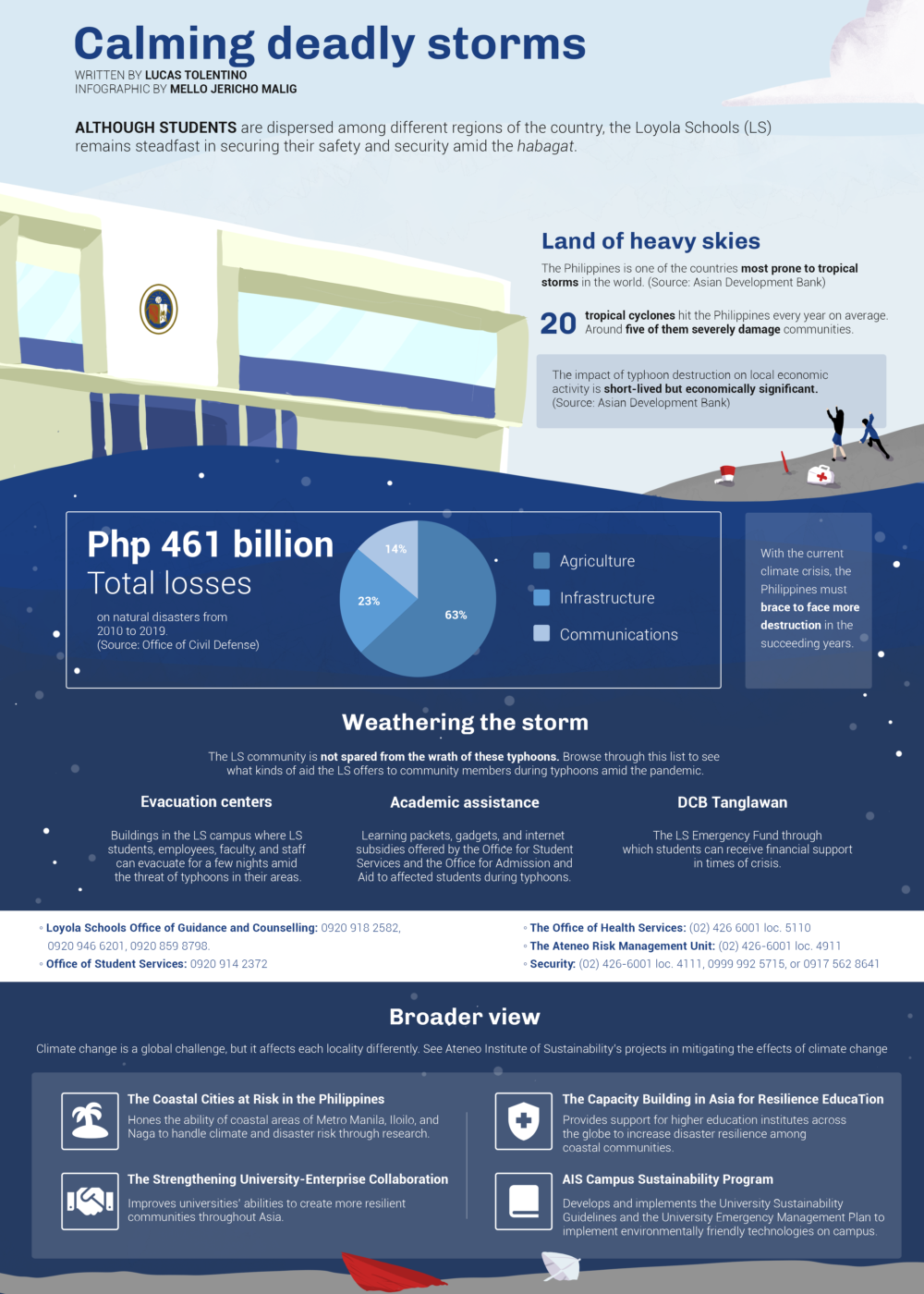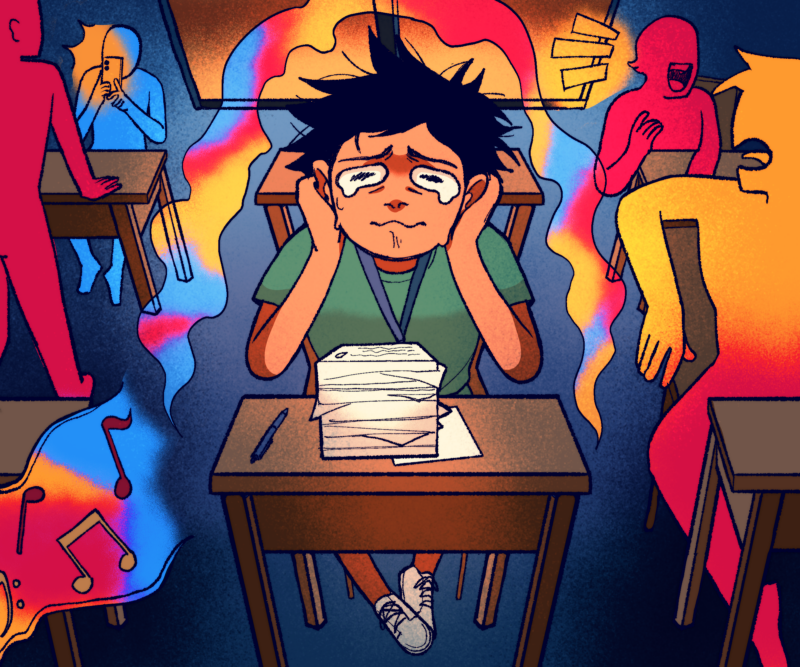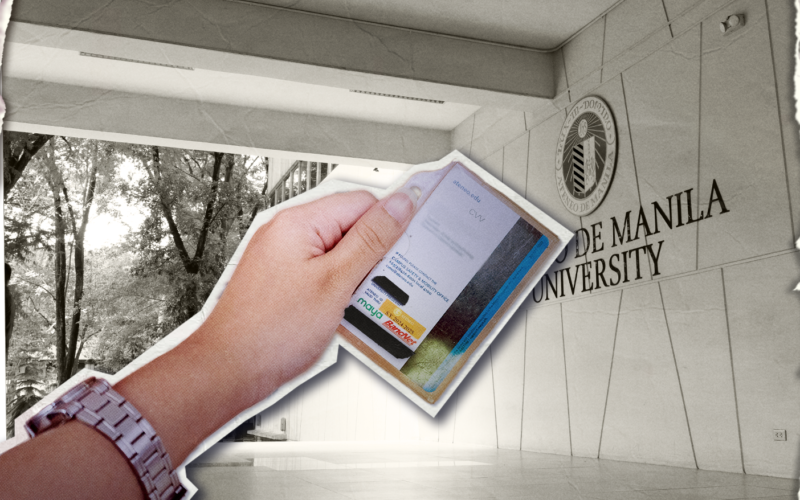EVERY YEAR, from July to November, the Philippines braces for the worst: Deadly floods, torrential rains, and raging winds in what is known as habagat or rainy season.
Although the Ateneo community used to find refuge in the confines of the Katipunan campus—built strong enough to withstand the heavy winds and rains—the onset of the pandemic has completely changed this. Community members are now in their own homes all across the country and can no longer evacuate to Katipunan so easily.
With habagat currently in full swing, the Loyola Schools (LS) administration and the Sanggunian face the daunting challenge of defying these geographical barriers in ensuring that their constituents are safe and dry.
A scattered Ateneo community
A hazard is a threat of a naturally occurring event that matures into a calamity when it has the potential to endanger the human population. Thus, crudely built, low-lying infrastructure in densely populated slums in the country lay waste for its residents in the wake of typhoons.
The human toll of these disasters are widely encompassing. Victims are uprooted from their homes and agricultural land, and farm crops are damaged. Miners and farmers employed in mountainous regions also fall victim to landslides.
Unfortunately, the same holds true among members of the LS community, as they too, are unexempt from the wrath of these disasters.
According to Sanggunian Vice President TJ Alcantara, LS students commonly suffer through days-long power outages and destruction of property. Even worse, some lose access to food, water, and shelter, which they struggle to find amid the looming health threat of the COVID-19 pandemic.
Moreover, students last year needed to bear the additional burden of juggling their online classes’ demands since some professors did not extend deadlines even during calamities.
Since then, the Vice President of the Loyola Schools has updated the guidelines to address online learning disruptions due to inclement weather in a bid to appease these turbulent conditions for AY 2021-2022.
Furthermore, Alcantara assures the student body that the Sanggunian does its best to monitor their needs and address them as soon as possible. In the wake of typhoons, for example, the Sanggunian conducts constituency checks and puts up emergency hotlines to check up on students. They also refer those in need of learning packets and financial aid to the Office for Student Services (OSS) and the Office for Admission and Aid, respectively.
Nonetheless, Alcantara admits that these efforts can only go so far. One of the most pressing problems that the Sanggunian faces now is addressing the needs of LS students in far flung areas where calamities hit hardest. Alcantara acknowledges that students face vastly different contexts and need varying kinds of assistance. Thus, he also emphasizes that the Sanggunian’s constituency checks must be augmented with other ways to gauge stakeholder welfare, which the Sanggunian is currently “hoping and planning” to do.
Beck and call on Eagle grounds
While such measures fall short in fully quantifying constituent’s needs amid calamities, the Sanggunian relays their concerns to the proper LS offices.
For LS students, employees, staff, and auxiliary personnel whose homes have been badly damaged by typhoons, the Campus Safety and Mobility Office (CSMO) opens up evacuation centers within the LS campus where they can stay for a few nights. The office also organizes evacuation centers in other school units for the rest of the Ateneo community.
In the wake of Typhoon Ulysses, which made landfall on November 8, 2020, OSS Director Michael Mallillin also says that the University rescued and transported employees and students to these evacuation sites. The University also deployed clean-up brigades at employees’ damaged residences—a form of assistance that will “potentially” continue in the future.
When these typhoons involve floods, the CSMO further opens the parking areas in the LS campus and allows LS community members to park their vehicles there.
Aside from such physical relief, an important aspect of typhoon response that has largely gone unnoticed is mental health support. Calamities are agents for psychological distress. The number of people grappling with mental health issues increases when disaster strikes, says Loyola Schools Office of Guidance and Counselling (LSOGC) Director Gary Faustino.
During these disasters, the LSOGC monitors areas that have been ravaged by calamities and announces to the people in these areas that the LSOGC is available for help. “You can come to us if, for example, this whole thing has traumatized you [or] you want to talk to someone,” says Faustino.
He emphasizes that students during such disasters must become self-aware of their mental state so they can consider reaching out to someone whom they trust. If these still can’t be addressed, then he advises students to avail of secondary care by talking to an LSOGC counsellor.
In the upcoming years, the role of self-awareness and mental health assistance becomes more important than ever, given how disruptive calamities become more frequent.
Piercing nature’s wrath
While the repercussions of such calamities make itself known on personal scales, it is but a piece in the puzzle of an even larger phenomenon.
These tropical cyclones that pummell the country are an effect of global warming and a worsening climate at large, which are largely due to human activities such as burning fossil fuels and cutting down forests that contribute to Greenhouse Gases (GHG).
At the University level, the Ateneo Institute of Sustainability (AIS) leads the fight against climate change. The AIS developed the University’s sustainable development agenda in 2013 and has since spearheaded several campus sustainability initiatives to achieve this.
Notably, the covered walkways and the e-jeeps on campus are included in the roster of AIS’ initiatives and are specifically designed to promote sustainable modes of transportation. On the other hand, the waste-water treatment and recycling practices are AIS’ other initiatives in conserving campus water resources.
As per the Ateneo Campus Sustainability Guidelines of 2016, these initiatives reduce GHG emissions and create conducive environments where pockets of flora and fauna may grow, effectively downscaling the impacts of the current climate crisis.
Such disaster reduction initiatives have shown great promise in minimizing the damaging effects of calamities.
“While there are natural hazards we can’t really control, such as volcanic eruptions or earthquakes, whether the hazard becomes a calamity or a disaster depends on how societies have been built, and whether we are resilient,” AIS Director Charlotte Gonzales points out.
Such devastating effects speak to the essence of disaster resiliency: Knowing when and how to correctly act in preparation for a calamity reduces disaster risk. Thus, disaster management programs remain crucial to society, as the way societies respond to natural phenomena calibrates the extent of a disaster.
At present, the Filipino populace must render primary concern over calamity response initiatives, seeing as how the rainy season is up and coming.
Alcantara stands firm that the Sanggunian will fulfill its duties to the student body: “Our mandate, our mission is of course to work for the best interests of our students. So we are putting the welfare of our students, of our community always at the center and always at the most important levels of what we do.”
With reports from Paolo Buenaseda







